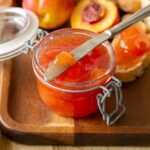
Peach Jam Without Pectin
Servings: 24 ( 2 medium jars)
Calories: 93kcal
This peach jam without pectin calls for just 3 ingredients and it's super easy and quick to make!
Print Recipe
Ingredients
- 1 kg peaches or 500g (17oz) pitted
- 450 g sugar
- 1 lemon preferably organic
Instructions
- Wash the peaches and pat them dry. Remove the peach stones, then weigh them, chop them roughly and place them in a large bowl.
- Add the juice of one lemon and two thick lemon peel slices to the bowl. Stir in the sugar, cover with cling film and refrigerate for 2 hours or up until 12 hours.
- Transfer the peach mixture into a deep, heavy-bottomed dutch oven or stockpot, and cook over low heat for about 45 minutes, stirring frequently.
- Once the jam has reached a foamy rolling boil, start checking if it's ready with a kitchen thermometer or using the "wrinkle test". The jam is ready when it reaches 220°F / 105°C or when you spoon a little jam on a chilled plate and it starts to wrinkle after one minute. If it still liquidy, continue to boil the jam for 5 minutes then retest until it's done.
- Use a spoon to skim any scum that has risen to the surface and discard it. Remove the pan from the heat, and discard the lemon peels.
- Allow the jam to cool, then you can leave it chunky, or blend it for a few seconds until it reaches your desired consistency.
Video
Notes
- You'll need 500g (17oz) of pitted peaches - about 1 kg (2.2 pounds) of unpitted peaches.
- Marinate the peaches for 2 hours up to overnight. A longer marinating time will increase the release of pectin from the lemon.
- A wide pan – big enough so that the fruit comes no more than halfway up the side – is better, as the jam will reach the setting point more quickly.
- Use a wooden spoon to stir your jam as it cooks, avoid metal utensils.
- The easiest way to test your jam is by using a kitchen thermometer, the setting point for jam is 220°F / 105°C.
- You should start checking the temperature when the homemade jam has reached a rolling, foamy boil.
- If you don't have a kitchen thermometer, try the “wrinkle test.” About 10 minutes before cooking the jam, place a heat-proof plate in the freezer. When it's time to test your jam, spoon a little onto the cold plate. If the surface of the jam wrinkles when you nudge it with your finger, the jam is ready.
Nutrition
Serving: 25g | Calories: 93kcal | Carbohydrates: 24g | Protein: 1g | Fat: 0.2g | Saturated Fat: 0.01g | Polyunsaturated Fat: 0.04g | Monounsaturated Fat: 0.1g | Sodium: 1mg | Potassium: 115mg | Fiber: 1g | Sugar: 23g | Vitamin A: 803IU | Vitamin C: 7mg | Calcium: 7mg | Iron: 0.2mg